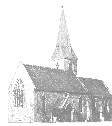
 |
INTRODUCTION |
Unquestionably, Cranham is an ancient place. This story is at least a thousand years long.
Permanent features of the parish are geographical. The first chapter in the story therefore begins with those permanent features and shows how people were superimposed on this constant background; the inhabitants may be viewed as historical actors on a geographical stage.
There is one overwhelmingly important geographical, permanent feature: Cranham is 19 miles east from London, and 10 miles or so north of the River Thames. This has always been of importance. The Thames was a trade route in Romano-British times, and we shall see that there may have been a need for a Roman Road through our parish. The development of the middle ages, expansion of farming, was dependent upon getting the produce of our fertile parish into London. Seventeenth century land transactions were driven by the London merchants who prospered and wanted profitable country estates. Modern development, of course has been dependent on the parish acting as a dormitory suburb. The history of Cranham has always been governed by its geographical location.
As many have said, the interior of the County of Essex has probably often been ignored due to the squalor and relative obscurity of Liverpool Street and Fenchurch Street railway stations. Not even the Essex coastal resorts are popular any more, and in any case they never did compare to places like Bath or Cheltenham. Both culpable railway stations are now renewed, so perhaps things will change. To many, Cranham is a relatively obscure parish in a relatively obscure region; but much of interest happened here.
With our geographical stage set, this website concentrates on the people at Cranham. Landowners, the church, public welfare, General Oglethorpe, and so on, are described in their own chapters; these are sub-plots in our drama. The interplay of all these events is obviously complex.
The reader is entitled to some knowledge of the author, and the likelihood of him being able to tell such a story. Nobody is omniscient, and perhaps some aspects of the thousand year drama will be less well described than others because of patchy defects in the author's education.
The author's qualifications amount to not much more than being a Cranham native, having a teacher at Oglethorpe Primary School that sparked his interest in local history, and then about 20 years of enthusiastic, but nonetheless amateur, research into the history of the parish; this was often interrupted by professional pursuits. Nonetheless, the latter (mostly in medicine and pharmacology) were turned to good use for this project since extended periods of time could be spent in Georgia. Whilst the author has no formal training in history, mediaeval law, or economics, he also doubts that those with such training would be interested in Cranham !
In the Essex Records Office, we have a resource unlike that for any other county in England. The author is grateful to those who have read the text and commented. Illustrations are individually acknowledged below. Kevin and Trevor Blackman helped with the churchyard gazetteer and the Coopers' School, respectively. Mr.Yeldham, sadly missed, provided some oral history. Three rectors gave me access to their records, and are acknowledged gratefully below. Dr.M.G.A.Vale, keeper of the archives at St.John's College, Oxford, was generous with his help.
This text contains many footnotes. They only record source materials and their location. The references can be ignored safely when reading. On the other hand, they do provide the interested reader with a way to check, and to criticise the interpretation of source materials.
Lastly, this material would never have appeared on the WWW without Jeffrey R.Kelsey. Jeff is a Cranham native, and we have been, literally, life-long friends (apart from a few childhood altercations!). This form of publication was entirely his idea, he is this site's Webmaster. The inclusion of graphics and the chapter on retail in Cranham are also entirely due to Jeff's interest in this project. I would also like to thank Mr Irvon Radford who, after he became aware of the website, contributed a number of photographs, many taken by himself, of Cranham during the 1950s and 1960s.
None of those acknowledged are in any way responsible for errors, or linguistic limitations. It is intended that this site will be updated periodically.
If you have any comments about these pages, or would simply like to drop us a line saying you have found them interesting, please feel free to contact either the author or Jeff Kelsey.
A.W.Fox
August, 1996.
La Costa, California
and Cranham, Essex.